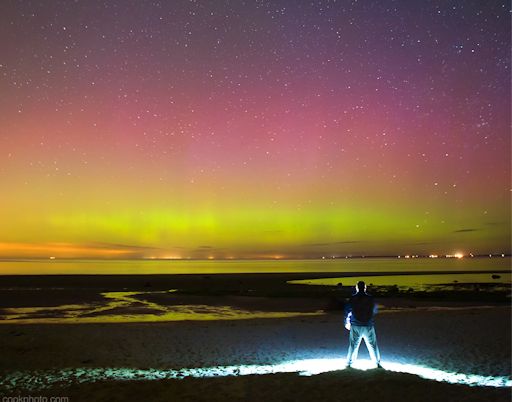Listen to radar echoes from satellites and meteors, live on listener-supported Space Weather Radio. | | |
BRIGHT EXPLOSION ON THE MOON: Recently, a small boulder hit the Moon and exploded with as much energy as 5 tons of TNT. NASA scientists say the explosion was bright enough to see with the naked eye. [full story] [video]
A BIG ASTEROID APPROACHES: Near-Earth asteroid 1998 QE2 is approaching the Earth-Moon system for a flyby on May 31st. There's no danger of a collision; at closest approach the asteroid will be 3.6 million miles away. Even at that distance, however, the 1.7-mile-wide space rock will be an easy target for mid-sized backyard telescopes. Using a 14-inch Celestron, Alberto Quijano Vodniza of Narino, Colombia took this picture of 1998 QE2 on May 17th:

The sunlit side of the asteroid will turn more squarely toward Earth during the first week of June. At that time it will reach a maximum brightness of 11th magnitude.
NASA radars will be monitoring the flyby, too. "Asteroid 1998 QE2 will be an outstanding radar imaging target at Goldstone and Arecibo and we expect to obtain a series of high-resolution images that could reveal a wealth of surface features," says radar astronomer Lance Benner of JPL. "Whenever an asteroid approaches this closely, it provides an important scientific opportunity to study it in detail to understand its size, shape, rotation, surface features, and what they can tell us about its origin."
Stay tuned for updates and observing tips.
Realtime Space Weather Photo Gallery
WEEKEND CME STRIKES: Over the weekend, a pair of CMEs hit Earth--one on May 18th (0100 UT) and another on May 19th (2250 UT). The impacts, especially the first one, rattled Earth's magnetic field and sparked Northern Lights visible as far south as Colorado. Some of the brightest appeared over Cape Cod, Massachusetts, where photographer Chris Cook took this self-portrait:

"This is the first time since September 2005 that the lights have been visible from here," says Cook. " It was a beautiful display. During the peak, which lasted about 20 minutes, I could see red and pink pillars with my unaided eye." With only a short exposure, Cook's camera revealed the true depth of color shown above.
More auroras are possible tonight as Earth's magnetic field continues to reverberate from the impacts. NOAA forecasters estimate a 20% chance of polar geomagnetic storms on May 20th. Aurora alerts: text, voice.
Realtime Aurora Photo Gallery
Realtime Comet Photo Gallery
Realtime Noctilucent Cloud Photo Gallery
[previous years: 2003, 2004, 2005, 2006, 2007, 2008, 2009, 2011]

